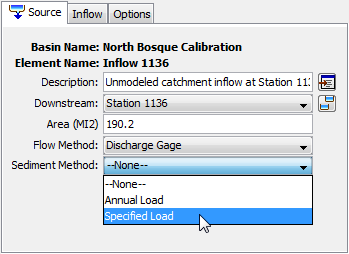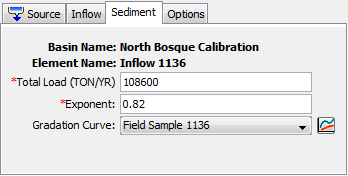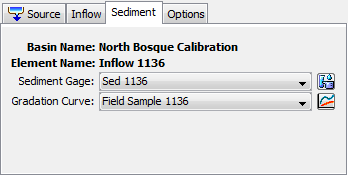Download PDF
Download page Source Sediment.
Source Sediment
A Source Element provides a way to introduce inflow to the channel network. Usually the inflow represents a portion of the upstream watershed that is not explicitly modeled in the basin model. Sometimes the inflow is computed in a separate simulation model, where the outflow hydrograph from that model becomes the inflow at the source element. Other times the inflow is observed at a flow measurement station and becomes the inflow at the source element. It is critical in a basin model that contains a source element to introduce both the water and sediment inflow at the source.
Selecting a Sediment Method
The Sediment Method for a source is selected on the Component Editor for the Source Element (shown in the following figure). Access the Component Editor by clicking the Source Element icon on the Components tab of the Watershed Explorer. You can also access the Component Editor by clicking on the element icon in the Basin Map, if the map is currently open. You can select a Sediment Method from the list of three available choices. If you choose the None method, the source will not compute any sediment and all sediment discharges from the element will be zero. Use the selection list to choose the method you wish to use. Each source is treated separately and should use an appropriate method for the area of the watershed above the source and the duration of the simulation.

The parameters for each Sediment Method are presented on a separate Component Editor from the Source Element editor. The Sediment editor is shown next to the Inflow editor once a Sediment Method has been selected. The information shown on the Sediment editor will depend on which method is currently selected.
Annual Load
The Annual Load Method applies an average annual sediment load to the discharge hydrograph with a methodology that may be suitable for continuous simulation applications where the land use is not changing in time. The total load must be distributed into a time-series in a manner that is consistent with the outflow hydrograph at the source. The method adopted in the program is to use an exponential form developed by Haan et al. (1994). The exponential equation is given by:
c_{t} = k(Q_{t}) ^{a}
where ct is the sediment concentration at time t, k is the ratio of the total sediment load for the time window to the total discharge for the time window, Qt is the source discharge at time t, and a is an exponent entered by the user. The Component Editor is shown in the following figure.

The Total Load specifies the accumulated sediment over all grain size classes for a typical year. The total load depends on the land use of the area upstream of the source element and can be highly variable due to local conditions. The load is fixed for the simulation time window.
The Exponent is used to distribute the sediment load into a time-series sedigraph. A small value flattens the sedigraph compared to the hydrograph. A large value heightens the sedigraph compared to the hydrograph.
The Gradation Curve defines the distribution of the total sediment load into grain size classes and subclasses. The gradation curve is defined as a diameter-percentage function in the Paired Data Manager. The current functions are shown in the selection list. If there are many different functions available, you may wish to choose a function from the selector accessed with the paired data button next to the selection list. The selector displays the description for each function, making it easier to select the correct one.
Specified Load
The Specified Sediment Method uses observed sediment load time-series data to determine the sediment to add to the flow at the source element. Observations of sediment are less common than observations of stream flow. In cases where observations are not available at the location of the source element, this method could be used for sediment computed from an external model of sediment discharge. The Component Editor is shown in the following figure.

The total sediment discharge at the source is specified with a Time-Series of Sediment Load. The time-series should represent the total of all grain size classes. The time-series data must be defined in the Time-Series Data Manager before it can be selected in the Sediment editor. The Time-Series button next to the selection list can be used to assist in selecting the correct sediment gage.
The total sediment discharge at the source is apportioned into grain size classes using a Grain Size Distribution Curve. The grain size distribution curve is specified with a diameter-percentage function. The function data must be defined in the Paired Data Manager before it can be selected in the Sediment editor. The Paired Data button next to the selection list can be used to assist in selecting the correct function.